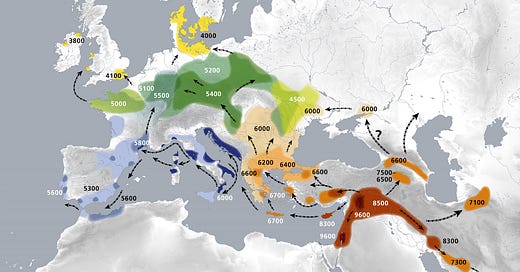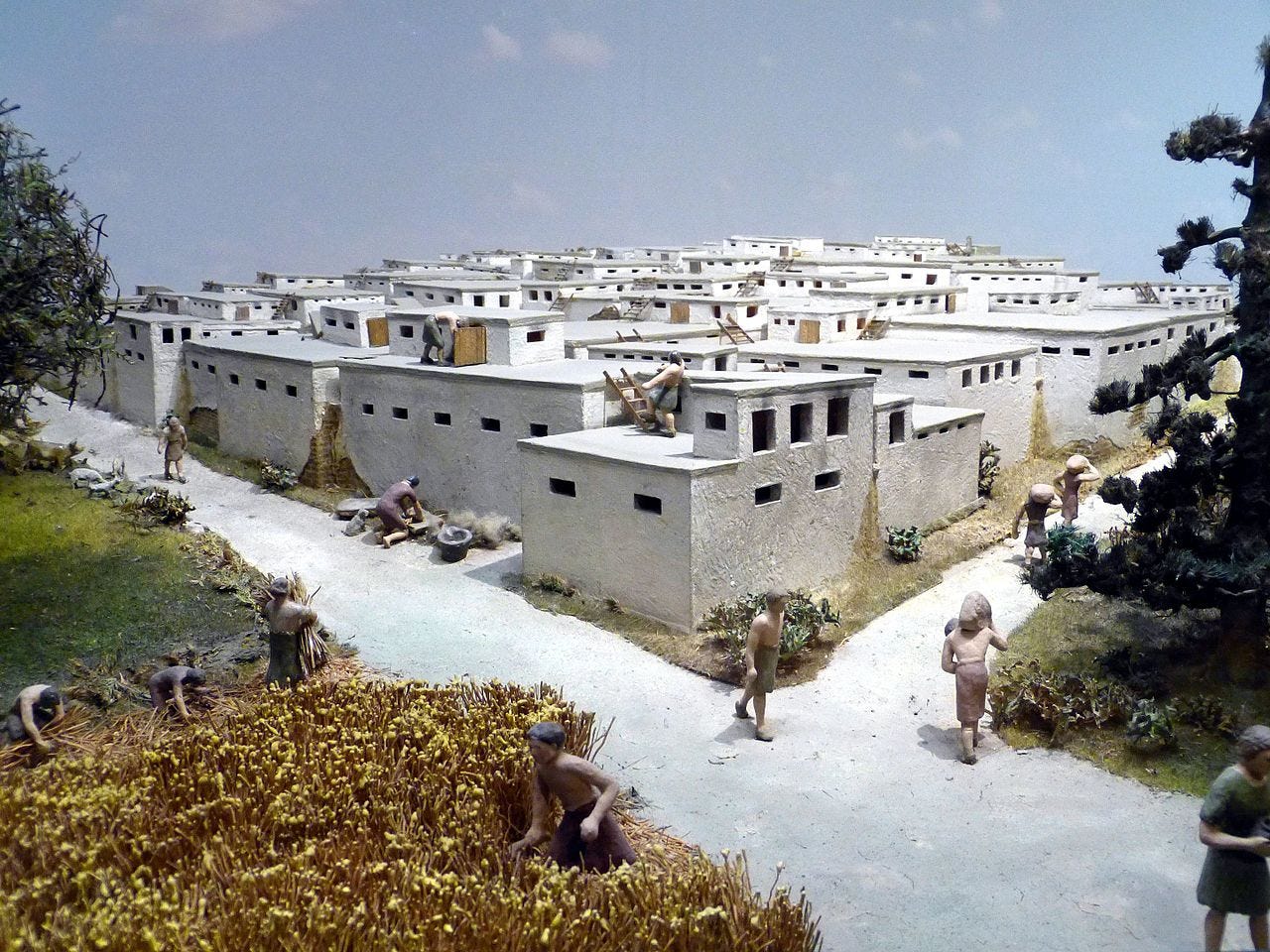Last time we began with a brief discussion of where exactly to start history and came to the conclusion that Noah would make the strongest candidate. Based on Noah’s righteousness him and his household are saved from the Flood, and God promises to never again destroy the earth, or humanity. He made no such promise with Adam, and as a result “Adam’s descendants” are entirely lost, with their cultures, histories, and ideals destroyed. Noah is a turning point where God initiates a period of ‘history’ upon the earth, something that can be traced and recorded.
Following the aforementioned Flood, Noah and his descendants began settled agriculture practices, namely planting vineyards and producing wine according to Genesis 9:20: “And Noah began to be a master of the soil, and he planted a vineyard.” The historical backdrop implies Noah’s requirement to gather animals and food is an indication that Noah existed on the cusp of domestication and agriculture.
We must turn to academia in order to corroborate this story, and indeed we find that while wild grains were utilized for multiple millennium1 the earliest evidence for proto-weeds starts approximately 21,000 BCE in the Levant, interestingly around the Galilee.2 These early proto-weeds were far from domesticated, and anything but what we have come to understand as settled agriculture.
While we do not see domestication in that era, by the time of the Natufian culture circa 13,000 BCE we see evidence for the production of bread at the site of Shubayqa, almost certainly from wild grains.3 Based on an analysis of mortars found in Raqefet cave, a Natufian burial site in Israel, this culture produces some sort of fermented beer-like drink;4 however, it is likely the result of accidental fermentation rather than produced for consumption.
According to scientific analysis of genetic data of Bronze Age Levantines, there was significant admixture of southeast Anatolian populations with those of the Natufian levant. While it is pure conjecture, there is the possibility these people came from a population whose ship landed in the mountains of Ararat, located in southeastern Anatolia.
It is not until the year 11,700 BCE in the Fertile Crescent that we see cultivation of crops such as barley, oats, and wheat. Scholars have come to call this period of rapid agricultural development and the domestication of wild species the “Neolithic Revolution”. At the same time, in the Fertile Crescent, we see evidence for cattle, goat, sheep, and even pig domestication.5 Whether a coincidence or not, both wild grains and wild animals were domesticated at the same time; potentially owing to a shared origin by a particular farmer able to maintain forms of lost wisdom whose evidence would have been washed away in a flood.
The Neolithic Fertile Crescent was settled by a population titled “Pre-Pottery Neolithic A”, or PPNA in shorthand. Potentially descendent from the earlier Natufian culture, these PPNA were responsible for the earliest Neolithic domestication as well as the building of the oldest known architecture, the Tower of Jericho.6 We are also aware of two other major sites called Gobekli Tepe and Catalhoyuk. Gobekli Tepe was founded around the year 9500 BCE and likely the site of major hunter-gather cultic practice. Within the region we see evidence for a transition to heavy domestication that occurs between the aforementioned PPNA and the later PPNB culture sometime between the year 8800 BCE. Whether or not animals were sacrificed as a result of this domestication at Gobekli Tepe is still unclear, but it was already abandoned by 8000 BCE. By 7500 BCE activity shifted west to Catalhoyuk where we find the first proto-city housing a population of nearly 10,000.7 Once again this site was occupied for an extremely long 1500 year's, and abandoned by 5700 BCE in favor of sites in the levant, and the emerging Sumeria. Over the span of roughly 7000 year's farming practices spread through Eurasia and Africa.
There is a tendency to discount the possibility of a “Noah”-like figure being scientifically reasonable. While the commonly known Haplogroups and concept of MRCA (Most Recent Common Ancestor) are well known in pop-sci, there is a lesser known concept called “Identical ancestors point”. The identical ancestor point is the most recent point in a population's past where a single individual is the ancestor of every person alive today. Definitionally this terminology would be what we are looking for when it comes to a “Noah” figure. Based on recent research the timeframe for the IAP is between 13,000 BCE and 3000 BCE.8 Slotting perfectly with the timeframe for Noah’s ark and subsequent population bottleneck. This research was confirmed in 2013 by Ralph and Coop that based on European genetics the IAP would have been around five thousand years ago.
Hopefully this has given you a quick foundation for the chapters to come. I am not interested in “proving” Noah’s existence, but merely attempting to show the basic story of the Bible is rooted in a structure much older than even the “stories” that could have been passed down. The ‘writer’ of the Bible wrote about things they didn’t know about, as we can see some of these subjects would have been entirely impossible to so accurately. There are no other mythologies, or legends that corroborate such a sequence of events, and this is uniquely a biblical structure.
Next time we will use this foundation as a basis to root our story in a historic structure. Sadly periods between settled agricultural practices and the invention of written records are stooped within ‘deep history’ and it would be uniquely challenging to illuminate much regarding this period of history. As the ages go by information increases and our understanding of events becomes stronger. Indeed the Bible itself continues to increase the size of the stories, with the vast majority of historically relevant material coming from the Kings period.
However, over the coming weeks we will see how even a single word in the Torah can be grounds for articles worth of content. It will be a few more posts until we reach the first son of Noah, but next week we will begin discussing geopolitics for this era of deep history.
As usual, don’t be afraid to contact me for question or suggestions as I’m still drafting and editing the long form text.
Harmon, Katherine (17 December 2009). "Humans feasting on grains for at least 100,000 years". Scientific American. Archived from the original on 17 September 2016. Retrieved 28 August 2016.
Snir, Ainit; Nadel, Dani; Groman-Yaroslavski, Iris; Melamed, Yoel; Sternberg, Marcelo; Bar-Yosef, Ofer; Weiss, Ehud (22 July 2015). "The Origin of Cultivation and Proto-Weeds, Long Before Neolithic Farming". PLOS ONE. 10 (7): e0131422.
Arranz-Otaegui, Amaia; Gonzalez Carretero, Lara; Ramsey, Monica N.; Fuller, Dorian Q.; Richter, Tobias (2018-07-31). "Archaeobotanical evidence reveals the origins of bread 14,400 years ago in northeastern Jordan". Proceedings of the National Academy of Sciences. 115 (31): 7925–7930.
"Fermented beverage and food storage in 13,000 y-old stone mortars at Raqefet Cave, Israel: Investigating Natufian ritual feasting". Journal of Archaeological Science: Reports. 21: 783–793.
Zeder MA (2011) The Origins of Agriculture in the Near East. Current Anthropology 52: S221–S235. [Google Scholar]
8000 BCE
Catalhoyuk diorama recreation.
Rohde DL, Olson S, Chang JT (September 2004). "Modeling the recent common ancestry of all living humans". Nature. 431 (7008): 562–6. Bibcode:2004Natur.431..562R.







